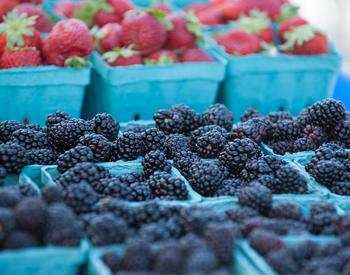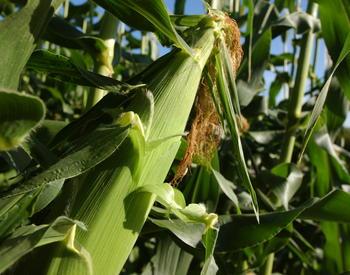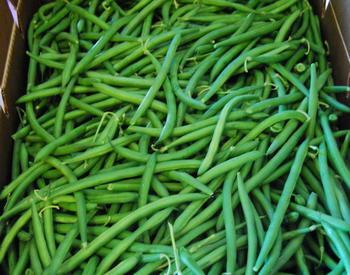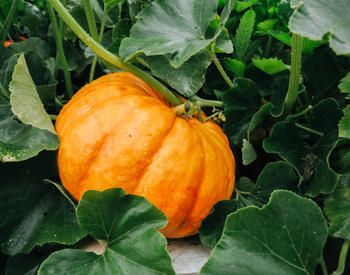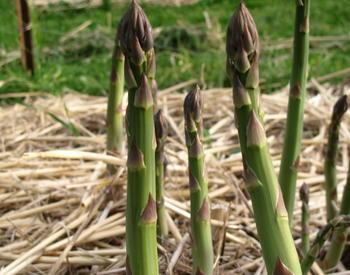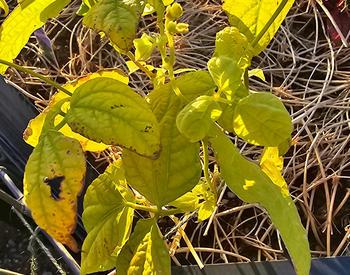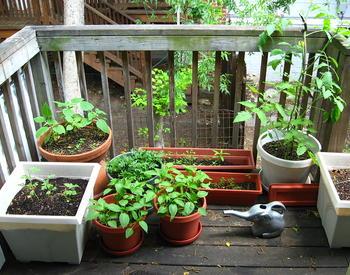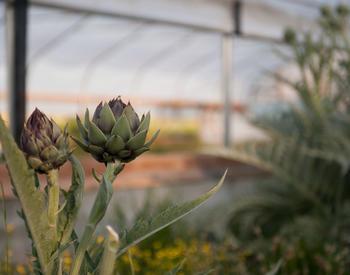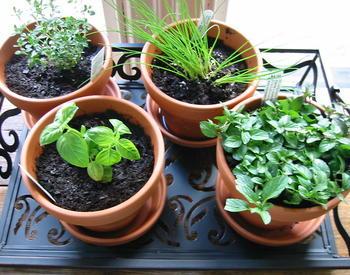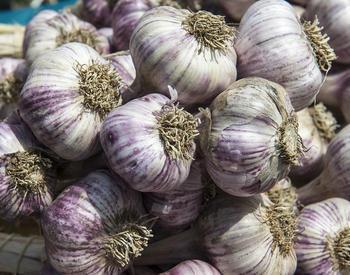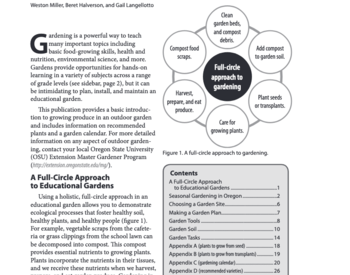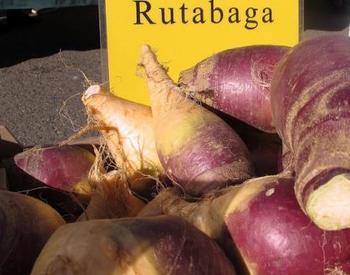Vegetables are not difficult to grow, but they do need more attention than most ornamental plants. With some crops you will get just one chance a year, so give them the attention and conditions they need right from the start.
Start with good soil, high in organic matter and a pH between 6 and 7. Be sure they have enough food and water to promote steady growth. Protect plants from wind, rain and frost. Prevent disease, and control or exclude hungry pests.
Artichokes
These perennials get larger and more productive each year, and they like our climate. They are tolerant of light frost, but not root hardy in wet and cold clay soil. Seeds take 21 days to germinate after chilling.
Aphids love them; keep a close eye out. If you see ants, look for aphids and wash them off with a hard spray of water, or dust with your favorite insecticide.
A good variety that will produce chokes the first year is 'Imperial Star'; others will take two years to produce.
Asparagus
Asparagus will grow anywhere in our region. These perennials need full sun. They will grow in mass and size of spears, spreading out, so they will need some space to grow into.
All male hybrids have been bred to produce more and larger spears instead of seeds. Whether grown from crowns or seeds, you can harvest lightly the second year and for about 6 weeks each year thereafter. Then the ferns must be allowed to grow and store energy for the next years’ crop.
Slugs are especially fond of new spears. Put bait out early, or you may find only a stump.
Beans
Bush beans take more space and can end up sprawling on the ground. They tend to set a crop and stop producing. Pole beans are more productive over a longer period. They require trellising, may grow 6–8 feet tall and will cast a shadow. They are easier to pick for people with old backs and knees.
Beans come in green, yellow and purple; the latter turn green when cooked. Beans require warm soil to germinate; if the soil is cold the seeds are liable to rot. They are easy and more dependable to grow as transplants. Sow 3–4 seeds to 4-inch pot indoors, on heat if possible. Transplant at two true leaf stage; handle carefully.
Dry shelling beans require a long warm season to mature and dry; even inland they are a gamble. Fava and soybeans both grow well here; consult catalogs for special needs.
Beets
Beets are a great crop in our climate, easy to grow with few pest or disease problems. They are easy to direct seed or can be grown as transplants. In the latter case be sure to plant them at no more than two true leaf stage.
Beets need a pH above 6, and boron, which our soils naturally lack. You can add a small amount of 20 Mule Team Borax — perhaps a teaspoon mixed into the fertilizer for a 3-by-3-foot plot. More is not better; boron in large amounts is a good herbicide. Beets need lots of water to produce good roots. Yellow, white and striped beets are open pollinated varieties, and results may vary. No major pests or diseases.
Broccoli
Broccoli is easy. It doesn’t like heat, so it is well suited to this climate. Broccoli is best grown from transplants, and easy to start from seed. It needs plenty of water and is a heavy feeder.
Check catalogs for seasonal varieties that can provide you with broccoli all year. After harvest of the first head, most will produce side shoots if well fed.
Common pests include aphids, cabbage worms and root maggots. 'Small Miracle; is a good, compact variety for small gardens. It makes a big central head, and it produces lots of side shoots.
Cabbage
Like broccoli, cabbage prefers to be cool; very warm temps will cause heads to split. Since the leaves are what we grow it for, it needs plenty of nitrogen. Keep well watered.
There are dozens of shapes and sizes, plus red and many shades of green. Savoy and Chinese cabbages are a bit fussier. Refer to catalog instructions for each type.
Cabbage is subject to all the problems of other brassicas and is a slug magnet! Once in, they don’t come out.
Cauliflower
Cauliflower is the fussiest of the brassica. It prefers to be cool, so it likes our climate. Like beets, cauliflower is also sensitive to boron deficiency. Stress or sudden temperature changes can cause it to bolt or “button,” which means making a tiny head on a tiny plant. If you see this in a pot of seedlings, pass them up. They will never grow a large head. Besides white, there are now green, yellow and fluorescent purple varieties.
Cauliflower seems to be more attractive to the fly that is responsible for root maggots. If any of your crucifers are wilting during the heat of the day and perk up in the morning, dig one up and check the roots for maggots. Prevention is difficult, but collars of paper may work. It may be possible to kill some of the maggots by dusting with insecticide around the base of the plants. Water it in lightly. Cabbage worms and slugs are fond of cauliflower.
Carrots
Most root crops do well here. Carrots like deep, loose soil to produce the longest roots, so raised beds are best. If you have heavy soil, try a short variety. Carrots must be direct seeded and kept moist so the soil surface never crusts over. They are slow to germinate, so a screen over the bed or some coconut fiber may help maintain moisture.
The three types in order of length are: Chantenay: short and fat, best for shallow or heavy soil. Nantes: medium length, the most common; and Imperator, very long, commercial-type carrots. The varieties meant to be grown as baby carrots will do well in shallow soil or containers.
Wire worms and carrot rust fly maggots will burrow into the root, effectively ruining it. Carrot rust flies can be excluded using row covers, but wire worms are more difficult. The problems seem to be regional.
Corn
Corn will not grow close to the ocean because it needs heat. If you are several miles inland and have full sun and a warm spot, it is worth a try. Choose early to midseason varieties, with a maximum of 80 days to maturity. Ultra early varieties will produce small ears but may not be as good as larger, later varieties.
It is important to understand the various types of corn and the needs of each. The super sweet types may need isolation from other corn types, and some need warm soil to germinate. 'Lucious', a new type called tablesweet, is a favorite. Corn is really big grass, so it needs plenty of nitrogen. It does not transplant well, so should be direct seeded when soil is warm.
For good pollination, plant in a square plot as possible. Corn is pollinated by wind, so if it is planted in long, single rows, you may not get good pollination. Cover the seedbed with floating row covers to enhance heat and foil crows and jays.
Our area sees few problems, besides an occasional corn ear-worm, earwigs and aphids.
Cucumbers
Cucumbers are an easy crop. They prefer to be warm and need some protection from the wind. They grow great in the greenhouse; trellis them up to keep fruit straight and clean. Seeds are best started inside on a heat mat, 75–80 degrees; they will not germinate in cold soil.
Hybridizing has bred out the bitterness common with older varieties. Since they are pollinated by bees or insects, the best and easiest cucumbers are seedless varieties with all-female blossoms that need no pollination to set fruit. The catalog description should say clearly that they will set fruit without pollination. Some to look for include 'Sweet Success', 'Diva' and 'Cool Breeze'. English cucumbers are best in the greenhouse; seed can be expensive, but they are well worth the money. Something to look for are hybrids 'Pepinex' or 'Socrates', and open-pollinated 'Tall Telegraph'.
Common problems include powdery mildew and 12-spot or striped cucumber beetles. Flea beetles like them as well.
Eggplant
This crop needs a lot of heat — more than peppers and tomatoes.
Few local gardeners have been successful. If you do want to try them, follow the directions for peppers. Choose small Asian varieties for the best possibility of success.
Garlic
Garlic is easy to grow. Garlic is clone propagated; it rarely has flowers and bears no true seed.
There are two different types of garlic: soft neck and hard neck. The soft necks have several layers of small cloves; this is what you find in the grocery store. The hard necks generally produce large bulbs with fewer and very large cloves. This type puts up a stiff stalk in the center. These stalks should be removed when they have made one curl to direct the energy to growing large bulbs. These tender stalks are delicious stir-fried.
Garlic needs sun and prefers loose, well-limed soil and moderate fertility. Plant on 5-inch centers in October to harvest the following summer. Mulch to discourage weeds and keep bed weed-free. Don’t water after June 1. Harvest when half the leaves show some yellowing; don’t leave in the ground too long, or they will split their wrappers. If in doubt, dig a bulb and check for clove development.
Hang in a warm dry place with leaves intact to cure for about a month. Clip tops to 1” and trim roots. Store at around 60 degrees in a dark dry place. An out of the way closet in the house works well. Refrigeration will break dormancy and promote growth. Save the largest cloves for seed to plant in October.
Greens
Many greens will grow well in our cool climate. They are especially good for spring and fall crops in the cloche, where they stay clean and don’t get battered by rain and hail. Most will transplant well.
The thing to remember is that you are growing them for their leafy parts, so they need plenty of nitrogen and water to grow fast. If they grow too slowly they are liable to be tough, taste strong or to bolt. Most greens are fast-maturing, so many will bolt no matter the weather. These need to be succession planted; sow seeds every couple of weeks to have a continuous supply.
Most are attractive to slugs and flea beetles.
Lettuce
Lettuce is an easy crop for anywhere in our area — in cloches or outside in the summer. Lettuce can be direct seeded, but is easy to start inside. It needs only bright light but no direct sun or heat to germinate. Seedlings transplant easily and are actually hard to kill. Like other tender greens, you will get the best lettuce if you protect it from heavy rain and hail. Lettuce also needs plenty of nitrogen and consistent moisture or it will bolt and get bitter.
You may choose from a huge number of varieties from baby lettuce to large heads of many colors and textures. Some newer varieties have some bolt resistance and heat tolerance bred in. Lettuce doesn’t cross-pollinate easily, so you can save seeds of your favorites. Plant seeds about once a month for a steady supply; set half out and hold the other half to be planted a week or two later.
The biggest problem is slugs; they crawl in and have no reason to come out. Bait as soon as lettuce is planted, and check plants often.
Onions
Onions need full sun and prefer light soil high in organic matter. Plant onions on 6-inch centers for the biggest bulbs. Onions grown from seeds are preferable to sets for a couple of reasons. Onion sets are more prone to disease, and a larger percentage will produce flower stalks. Seed-grown onions may get larger, and many more varieties are available. They are easy to start. Plant in March in deep pots for long, healthy roots.
There are two different onion types; long day and short day. In our latitude we need long day types, since day length governs bulbing. New day neutral varieties, crosses of the two types, are not subject to day length and have the potential to get very large.
Onions have shallow roots, needing an inch of water a week. Weeds will steal nutrients and water; keep beds weed-free. Onions are relatively free of problems, but onion maggots may attack. Check the roots if onions are not showing good growth and use insecticide if necessary.
In late summer when half the onion tops have fallen over, bend the rest over and leave for a few days. An enzyme in the neck tells the onion to go dormant. Pull onions carefully, keeping tops intact. Hang in a warm, dry place to cure. Cut tops to 1 inch and trim roots. Length of storage depends on the variety of onion. Store in a cool, dry place.
Peas
Peas will grow anywhere in our area but should be protected from the wind. Choices include shelling peas, sugar pod and snap peas. Several varieties have been developed at Oregon State University.
When soil is wet and cold, pre-sprout in the house in a tray between two layers of wet paper towels. Maintain moisture but don’t drown them. When the root becomes visible (after four–five days), place on the top of a prepared bed and cover with compost or soil. When planting out at this stage, use a dusting of insecticide to protect the vulnerable seeds.
Build supports out of anything the peas can cling to; string and stakes work well. Unsupported, they will sprawl on the ground and be targets for crawling insects, disease and dirt.
Powdery mildew is a common problem but can be discouraged with good air circulation. Aphids like peas; these pests spread a disease called pea enation mosaic virus. Newer varieties have resistance or tolerance to this disease bred in, but you still need to watch for aphids.
Plant peas every few weeks from late winter to midsummer for a continuous supply.
Peppers, sweet or hot
Peppers need a warm atmosphere to grow and produce; full sun is best. Even with a good cover, trying to grow them in close proximity to the ocean may not work. Hot peppers are easier to grow than sweet, but may not reach their full heat potential without being grown in a warm location.
They are heavy feeders that need good nutrition and irrigation. When looking at sweet varieties, choose ones that state they are good in cool climates.
Plants require support; a small tomato cage is just right. Green peppers are not ripe and not sweet, but any red variety can be grown for green peppers. The sweetest peppers are those that are allowed to get ripe and fully colored.
Slugs love the peppers, and aphids like the leaves. Peppers are subject to the same diseases as tomatoes.
Potatoes
Potatoes grow well in the coastal climate and anywhere in our region. They are easy and will do especially well in light, sandy soil, needing only moderate fertilizer and water. There are many combinations of colors of skin and flesh; yellow kinds look like they’ve been buttered. There are many types, from fingerlings to huge lunkers, with many different textures. Some bake or mash better, and some are waxy and firm.
Do not lime soil where you plan to plant potatoes; keeping the soil on the acid side will help discourage scab disease. Scabby potatoes, although unsightly, are edible.
Potatoes can be planted fairly early. Although they are not frost tolerant, they will grow again if frosted. Too much water and fertilizer will cause the potatoes to grow too fast and get a disorder called hollow heart. Hollow heart is basically an empty spot in the middle; you’ll know it if you see it.
Pests that like potatoes are flea beetles and wire worms. Flea beetles eat pinholes in the leaves and lay eggs that when hatched will burrow into the potato; dusting the leaves with insecticide will control them. Wire worms, the larvae of click beetles, will also burrow into the flesh, ruining it. These are hard to control; learn what they look like and kill them as they appear.
Pumpkins and winter squash
Pumpkins will grow close to the ocean with some wind protection; small, early ones work best. Winter squash must be grown inland; they need heat and a long season to produce a sweet flesh. Good fertility and plenty of water will produce big fruits. Some of the newer hybrids are very sweet. There are many beautiful heirlooms available from around the world.
Pumpkins and squash can be direct seeded, but starting them inside will give you a head start on the long growing season. They transplant easily if handled carefully.
Powdery mildew is a problem in our climate; it blocks the plants' ability to convert solar energy to sugar. It needs to be prevented so that the squash or pumpkin will attain large size and maximum sweetness.
All squash types need to be pollinated. Pollination problems occur if there are no bees, or if there is only one plant. Growing more plants will increase the probability that you will have a male and a female blossom open on the same day. Transfer ripe pollen with a brush in midday from the male blossom to the female blossom. The female blossom has a miniature fruit; the male blossom has only a stem.
Harvest before frost; store cool and dry, not cold. Squash may not develop full sweet flavor for a month or so.
Summer squash
Most summer squash are easy and will grow close to the ocean with wind protection. Squash need good food and water to keep producing. Squash grow rapidly; keep them picked to promote continued production.
Most summer squash varieties will cross-pollinate. If you only grow one plant, pollination is the biggest problem. Grow at least two or three to ensure that you get male and female blossoms open at the same time. If you don’t want all zucchinis, plant a couple of other kinds; there are many colors and types to choose from. Saved seeds will produce interesting crosses.
When small they need protection from slugs and beetles. Once plants get some size, there are few insects that can harm them. Powdery mildew is the biggest problem for squash in our climate; it must be controlled to get continued production. Some varieties have silvery markings on the leaves that resemble mildew but are not.
Tomatoes
Depending on where you live, it is possible to grow your own tomatoes. You will need at least eight hours of sun. If you live close to the ocean. a southwest exposure is best; use a wall to radiate heat. Sun and heat are what makes tomatoes sweet! You will need some kind of cover. It can be a simple cloche or a greenhouse. The cloche can be a large cage wrapped in clear plastic. Without cover you will not get ripe tomatoes. Though tomatoes are self-pollinating, those grown under cover need help with pollination.
Choose early maturing varieties, 80 days or less. If you are close to the ocean, fewer days is better. For our climate, you should add about two weeks to the stated days to maturity. Cherry or small-fruited tomatoes may have a better chance of ripening. A couple of short, compact cherry tomatoes are 'Honey Bunch Grape' and 'Sweet Baby Girl'.
Start your own seeds if possible; that way you can choose varieties that are best suited to your conditions. Look for disease-resistant varieties. Tomatoes like good fertility but not too much nitrogen. You want steady growth and good green leaves. Keep moisture consistent, especially when plants are fruiting. You can grow tomatoes in pots, but keep them well watered.
Tomato Growth Type
The single most important detail in choosing a tomato variety is the growth type.
Determinate varieties are shorter and more compact; some are dwarf and may not need much support. This type sets one crop of fruit. Determinate tomatoes are good if you live close to the ocean or are growing in a cloche.
Indeterminate varieties continue to grow taller and keep producing more blossoms and setting more fruit, until killed by frost. They also require more pruning to keep them under control. They can easily take over a cloche or grow out of the space allotted. Most (not all) “heirloom” tomatoes are indeterminate; these will grow large plants and may be slow to ripen fruit.
The main issues are, do you have space for a 6- or 7-foot plant, and will all the fruits ripen? If you are close to the ocean, it may make more sense to grow a determinate type that will get a good fruit set. You don’t need a huge plant with a lot of green fruit on it in November.
All tomatoes should have support to keep them off the ground. If you are going to grow an indeterminate variety, be prepared to support it. If they are planted outside with a large cage, you will need to secure the cage to a sturdy stake, or two, to keep it from falling over.
Tomato Diseases
Tomatoes are subject to a number of diseases. Most are hard to identify and not common in our area. Late blight is a devastating, fast-moving fungus that shows up when the weather conditions are just right, usually late in the season. It starts with a small gray patch on one leaf; soon there are more. It leaves foliage looking burnt, and soon it affects the fruits and kills the plant. There is no cure.
Prevention is key! Organic and conventional sprays started early and used weekly should keep plants healthy. Some varieties have resistance to some diseases bred in, but not to this particular disease.
Do not smoke around the plants or handle them if you have been smoking. Tobacco mosaic virus affects tomatoes and can be carried in cigarettes. Do not irrigate overhead, and avoid splashing water on the leaves.
Destroy any diseased plant parts by burning them or putting them in the trash. Do not put grocery store tomato or potato trimmings in the compost. Since they are subject to the same diseases, you should not compost any tomato or potato parts. As much as possible, rotate your crops.
Blossom end rot is a condition; it is not a disease. It is a calcium deficiency caused by irregular or insufficient water. It shows up as a dry, leathery brown patch on the blossom end. It is unsightly but does not affect the tomato.
